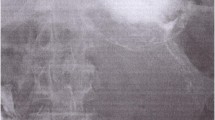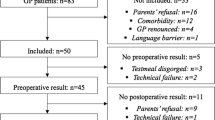Abstract
Purpose
Absence of consistent data on the outcome of gastric emptying after fundoplication raises concerns about preoperative workup and surgical management. This study assessed how gastric emptying evolves after isolated fundoplication in order to determine whether a preoperative investigation and/or a concurrent gastric drainage procedure are justified.
Methods
Eleven children with GERD underwent both pre- and post-operative gastric emptying scintigraphy. No gastric drainage procedures were added to fundoplication. Scintigraphy was performed according to a standardized protocol (labeled meal, 300 ml + 500 μCi 99mTc/m2 bsa). Half-emptying time (t 1/2), emptying rate and fractions of retention are expressed as the median followed by the [range]; statistical significance level was set at 5%.
Results
Postoperative t 1/2 (min) showed a much smaller dispersion and was significantly lower than preoperative one (76 [56;101] vs. 107 [57;186], p = 0.04) with a variation of −48 [−105;19]; there was no individual correlation between pre- and post-operative measurements (r = 0.25). The proportion of patients with delayed gastric emptying (t 1/2 > 100) was significantly lower in the postoperative scintigraphy (9 vs. 55%, p = 0.03). The postoperative emptying rate (%/h) was significantly faster (35.1 [18.9;41.7] vs. 28.5 [16.3;38.7], p = 0.05). The retentions (%) at 30 and 60 min were similar; at 90 and 120 min were significantly lower after surgery (45 [35;54] and 32 [24;46] vs. 53 [33;78] and 41 [25;66], p = 0.03 and 0.05).
Conclusion
Gastric emptying accelerates significantly after fundoplication with a shift to normal values in the vast majority of patients. Scintigraphy does not predict the postoperative outcome. Therefore, concomitant drainage procedures seem unnecessary and preoperative gastric emptying study not useful.


Similar content being viewed by others
References
Schoeman MN, Tippett MD, Akkermans LM et al (1995) Mechanisms of gastroesophageal reflux in ambulant healthy human subjects. Gastroenterology 108:83–91
Penagini R, Hebbard G, Horowitz M et al (1998) Motor function of the proximal stomach and visceral perception in gastro-oesophageal reflux disease. Gut 42:251–257
Estevão-Costa J, Campos M, Dias JA et al (2001) Delayed gastric emptying and gastroesophageal reflux: a pathophysiologic relationship. J Pediatr Gastroenterol Nutr 32:471–474
Argon M, Duygun U, Daglioz G et al (2006) Relationship between gastric emptying and gastroesophageal reflux in infants and children. Clin Nucl Med 31:262–265
Richter JE (1997) Delayed gastric emptying in reflux patients: to be or not to be? Am J Gastroenterol 92:1077–1078
Bustorff-Silva J, Fonkalsrud EW, Perez CA et al (1999) Gastric emptying procedures decrease the risk of postoperative recurrent reflux in children with delayed gastric emptying. J Pediatr Surg 34:79–83
Elashoff JD, Reedy TJ, Meyer JH (1982) Analysis of gastric emptying data. Gastroenterology 83:1306–1312
Velasco N, Hill LD, Gannan RM et al (1982) Gastric emptying and gastroesophageal reflux. Effects of surgery and correlation with esophageal motor function. Am J Surg 44:58–61
Soykan I, Lin Z, Jones S et al (1997) Gastric myoelectrical activity, gastric emptying and correlations with dyspepsia symptoms in patients with gastroesophageal reflux. J Investig Med 45:483–487
Holloway RH, Hongo M, Berger K et al (1985) Gastric distention: a mechanism for postprandial gastroesophageal reflux. Gastroenterology 89:779–784
Cucchiara S, Bortolotti M, Minella R et al (1983) Fasting and postprandial mechanisms of gastroesophageal reflux in children with gastroesophageal reflux disease. Dig Dis Sci 38:86–92
Kawahara H, Dent J, Davidson G (1997) Mechanisms responsible for gastroesophageal reflux in children. Gastroenterology 113:399–408
Cucchiara S, Minella R, Iorio R et al (1995) Real-time ultrasound reveals gastric motor abnormalities in children investigated for dyspeptic symptoms. J Pediatr Gastroenterol Nutr 21:446–453
Borgstein ES, Heij HA, Beugelaar JD et al (1994) Risks and benefits of antireflux operations in neurologically impaired children. Eur J Pediatr 53:248–251
Pittschieler K (1991) Dumping syndrome after combined pyloroplasty, fundoplication. Eur J Pediatr 150:410–412
Maxson RT, Harp S, Jackson RJ et al (1994) Delayed gastric emptying in neurologically impaired children with gastroesophageal reflux: the role of pyloroplasty. J Pediatr Surg 29:726–729
Cucchiara S, Salvia G, Borrelli O et al (1997) Gastric electrical dysrhythmias and delayed gastric emptying in gastroesophageal reflux disease. Am J Gastroenterol 92:1103–1108
Parkman HP, Fisher RS (1997) Contributing role of motility abnormalities in the pathogenesis of gastroesophageal reflux disease. Dig Dis 15(Suppl 1):40–52
Johnson DG, Reid BS, Meyers RL et al (1998) Are scintiscans accurate in the selection of reflux patients for pyloroplasty? J Pediatr Surg 33:573–579
Jawaid W, Abdalwahab A, Blair G et al (2006) Outcomes of pyloroplasty and pyloric dilatation in children diagnosed with nonobstructive delayed gastric emptying. J Pediatr Surg 41:2059–2061
Fonkalsrud EW, Ellis DG, Shaw A et al (1995) A combined hospital experience with fundoplication and gastric emptying procedure for gastroesophageal reflux in children. J Am Coll Surg 180:449–455
Okuyama H, Urao M, Starr GA et al (1997) A comparison of the efficacy of pyloromyotomy and pyloroplasty in patients with gastroesophageal reflux and delayed gastric emptying. J Pediatr Surg 32:316–320
Wijnhoven BPL, Salet GAM, Roelofs JMM et al (1998) Function of the proximal stomach after Nissen fundoplication. Br J Surg 85:267–271
Vu MK, Straathof JWA, PJ v d Schaar et al (1999) Motor and sensory function of the proximal stomach in reflux disease and after laparoscopic Nissen fundoplication. Am J Gastroenterol 94:1481–1489
Vu MK, Ringers J, Arndt JW et al (2000) Prospective study of the effect of laparoscopic hemifundoplication on motor and sensory function of the proximal stomach. Br J Surg 87:338–343
Bais JE, Samson M, Ondesteijn EAJ et al (2001) Impact of delayed gastric emptying on the outcome of antireflux surgery. Ann Surg 234:139–146
Lindeboom MYA, Ringers J, van Rijn PJJ et al (2003) Function of the proximal stomach after partial versus complete laparoscopic fundoplication. Am J Gastroenterol 98:284–290
Lindeboom MYA, Ringers J, van Rijn PJJ et al (2004) Gastric emptying and vagus nerve function after laparoscopic partial fundoplication. Ann Surg 240:785–790
Mousa H, Caniano DA, Alhajj M et al (2006) Effect of Nissen fundoplication on gastric motor and sensory functions. J Pediatr Gastroenterol Nutr 43:185–189
Pacilli M, Pierro A, Lindley KJ et al (2008) Gastric emptying is accelerated following laparoscopic Nissen fundoplication. Eur J Pediatr Surg 18:395–397
Khajanchee YS, Dunst CM, Swanstrom LL (2009) Outcomes of Nissen fundoplication in patients with gastroesophageal reflux disease and delayed gastric emptying. Arch Surg 144:823–828
Struijs M-C, Lasko D, Somme S, Chiu P (2010) Gastric emptying scans: unnecessary preoperative testing for fundoplications? J Pediatr Surg 45:350–354
Urbain J-L, Charkes ND (1995) Recent advances in gastric emptying scintigraphy. Semin Nucl Med 25:318–325
Estevão-Costa (2004) Gastric emptying and pediatric gastroesophageal reflux. In: Esposito C, Montupet P, Rothenberg S (eds) The gastroesophageal reflux in infants and children. Springer-Verlag, Berlin, pp 135–145
Moragas G, Azpiroz F, Pavia J, Malagelada J-R (1993) Relations among intragastric pressure, postcibal perception, and gastric emptying. Am J Physiol 264:G1112–G1117
Author information
Authors and Affiliations
Corresponding author
Rights and permissions
About this article
Cite this article
Estevão-Costa, J., Fragoso, A.C., Prata, M.J. et al. Gastric emptying and antireflux surgery. Pediatr Surg Int 27, 367–371 (2011). https://doi.org/10.1007/s00383-010-2702-6
Accepted:
Published:
Issue Date:
DOI: https://doi.org/10.1007/s00383-010-2702-6




